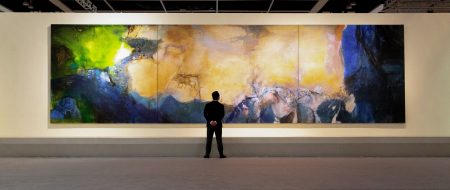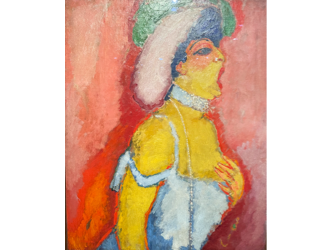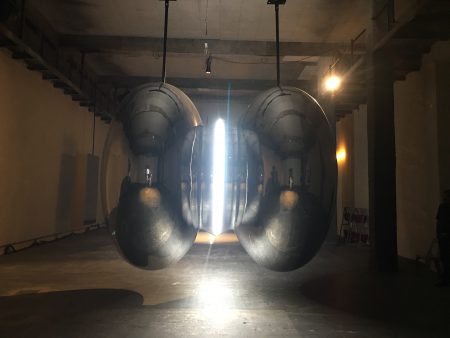Visual gust of wind
Seeing a substantial exhibition of Paul Cézanne (1839-1906) is like being caught up in a visual gust of wind. There’s the beauty of the reddish and green hues that caress you, but also the simplified or even crude forms, the shadows treated like major subjects, the unstable equilibrium of his objects – it all makes your head spin. He plays with hot and cold, beauty and ugliness. Cézanne creates, and he shakes you up. Harmony and imbalance… (See here a report about Cézanne and portraits)
Sense of mystery

The Aix master produces a sense of mystery that is disconcerting. Cézanne doesn’t create seductive paintings. They are captivating. This sensory experience functions, we should recall, only with paintings in real life, not reproductions. If you want to experience this right now there is only one solution: visit the Tate Modern in London.
Natalia Sidlina
They are staging a retrospective until 12 March comprising 80 artworks. The exhibition is spread rather thin conceptually, but the paintings make up for it. The curator of the exhibition, Natalia Sidlina, explains that with every era the very complex Cézanne has been interpreted differently. “We note that today visitors to the exhibition are particularly interested in details about his personal life. His relationship with his wife, who would be his principal model, the fact that he felt the need to isolate himself in L’Estaque – with an entire room dedicated to this subject – his friendships with Emile Zola, another Aixois…

The catalogue raisonné
Plus the recent publication of Cézanne’s catalogue raisonné online is an inexhaustible source of information on the painter that is accessible to all.”
Artist’s artist

The most fascinating aspect touched on by the exhibition at the Tate is the legacy the artist has established among modern and contemporary artists. “Cézanne is an artist’s artist par excellence,” highlights Natalia Sidlina. Cézanne, who received a private income from his banker father, had no need to sell his works so they were not widely exhibited. This is why, for example, in order to admire Cézanne Paul Gauguin bought one of his paintings, “Nature morte au compotier”, from 1879-80, which is now owned by Moma and is on display in London.
Picasso about Cézanne

Picasso spoke freely about him, describing him as “the father of us all”, and the portrait of Cézanne’s son from 1880 with his black eyes like marbles could be confused for one of the Spanish master’s early paintings. He owned four works by the Aix artist, two of which feature in the Tate’s exhibition. His influence was such that in 1958 Picasso bought the Château de Vauvenargues near Aix. To announce the news to his dealer, Kahnweiler, he called him up to say: “I have bought the Montagne Sainte-Victoire”. This was not in fact in reference to a painting but to the view of Cézanne’s favourite mountain, which could be seen from Picasso’s new property.
On 9 November 2022 Christie’s sold a “Montagne Saint Victoire” from the Paul Allen collection (see the report on the subject) for the new record price at auction for the artist of 137.9 million dollars.
The greatest of us wall

Monet said of Cézanne that he was “the greatest of us all”, and we can understand the fascination with this contemplator of nature when we observe a landscape of the famous Sainte Victoire with a foreground of blue and green foliage, composed of little blocks of ridged colours to express the movement of the leaves. The father of the Water Lilies also had a painting by the Aix artist, exhibited in London, the portrait from behind – in an almost expressionist style – of a black man, Scipio, dating from 1866 (See here a report about the exhibition Le modèle noir staged at musée d’Orsay featuring Scipio).
Artistic anthropophagic ritual

The exhibition also reveals more recent artistic fascinations. The American Jasper Johns is the lucky owner of two works by Cézanne, including a gouache from 1877, “l’Eternel féminin”. Two years earlier Cézanne started work on a painting, “L’après-midi à Naples”, depicting an entwined couple being waited on by a servant. An intimate scene that used to belong to the British artist Lucian Freud, who is also currently the subject of an excellent retrospective at the National Gallery. Like in an artistic anthropophagic ritual, the great masters of painting are nourished by the artworks of their elders.

Until 12 March. Cezanne. Tate Modern. www.tate.org.uk
Support independent news on art.
Your contribution : Make a monthly commitment to support JB Reports or a one off contribution as and when you feel like it. Choose the option that suits you best.
Need to cancel a recurring donation? Please go here.
The donation is considered to be a subscription for a fee set by the donor and for a duration also set by the donor.





